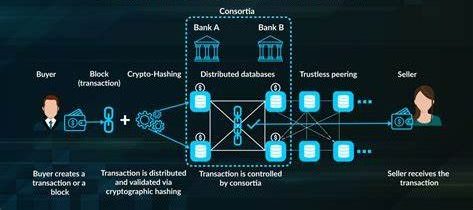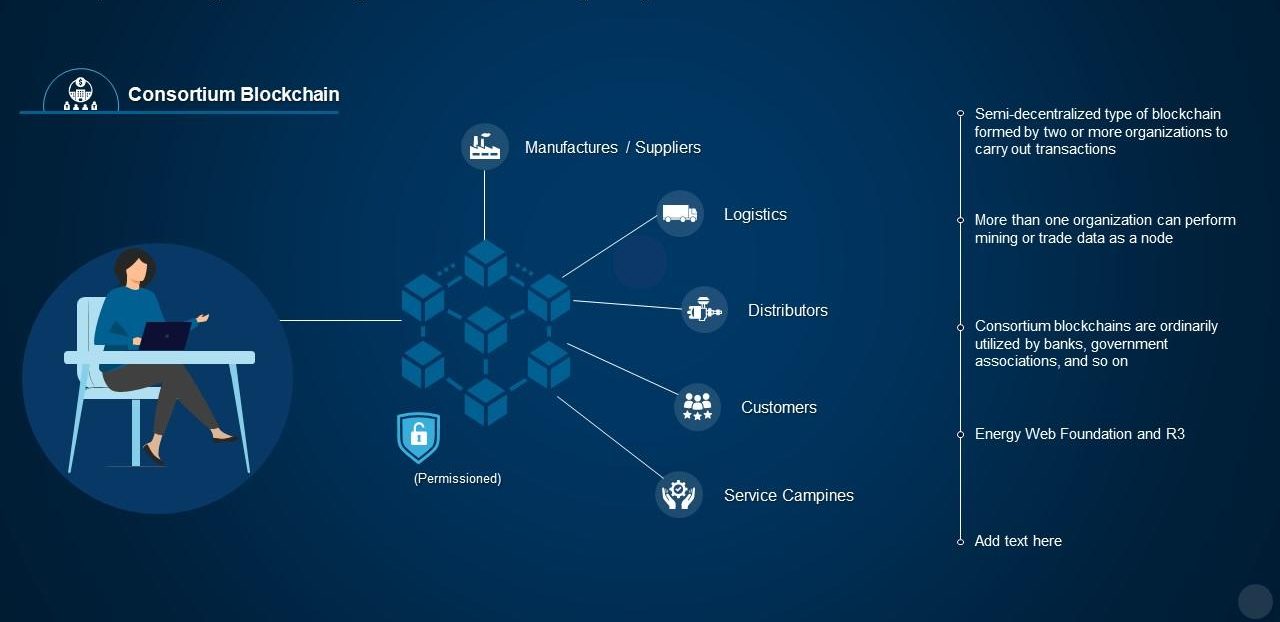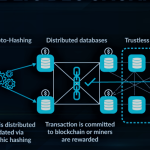Blockchain
A blockchain is a distributed ledger with growing lists of records (blocks) that are securely linked together via cryptographic hashes. Each block contains a cryptographic hash of the previous block, a timestamp, and transaction data (generally represented as a Merkle tree, where data nodes are represented by leaves). Since each block contains information about the previous block, they effectively form a chain (compare linked list data structure), with each additional block linking to the ones before it. Consequently, blockchain transactions are irreversible in that, once they are recorded, the data in any given block cannot be altered retroactively without altering all subsequent blocks.
 Blockchains are typically managed by a peer-to-peer (P2P) computer network for use as a public distributed ledger, where nodes collectively adhere to a consensus algorithm protocol to add and validate new transaction blocks. Although blockchain records are not unalterable, since blockchain forks are possible, blockchains may be considered secure by design and exemplify a distributed computing system with high Byzantine fault tolerance.
A blockchain was created by a person (or group of people) using the name (or pseudonym) Satoshi Nakamoto in 2008 to serve as the public distributed ledger for bitcoin cryptocurrency transactions, based on previous work by Stuart Haber, W. Scott Stornetta, and Dave Bayer.
Blockchains are typically managed by a peer-to-peer (P2P) computer network for use as a public distributed ledger, where nodes collectively adhere to a consensus algorithm protocol to add and validate new transaction blocks. Although blockchain records are not unalterable, since blockchain forks are possible, blockchains may be considered secure by design and exemplify a distributed computing system with high Byzantine fault tolerance.
A blockchain was created by a person (or group of people) using the name (or pseudonym) Satoshi Nakamoto in 2008 to serve as the public distributed ledger for bitcoin cryptocurrency transactions, based on previous work by Stuart Haber, W. Scott Stornetta, and Dave Bayer.
 The implementation of the blockchain within bitcoin made it the first digital currency to solve the double-spending problem without the need of a trusted authority or central server. The bitcoin design has inspired other applications and blockchains that are readable by the public and are widely used by cryptocurrencies.
The blockchain may be considered a type of payment rail.
Private blockchains have been proposed for business use. Computerworld called the marketing of such privatized blockchains without a proper security model “snake oil”; however, others have argued that permissioned blockchains, if carefully designed, may be more decentralized and therefore more secure in practice than permissionless ones.
The implementation of the blockchain within bitcoin made it the first digital currency to solve the double-spending problem without the need of a trusted authority or central server. The bitcoin design has inspired other applications and blockchains that are readable by the public and are widely used by cryptocurrencies.
The blockchain may be considered a type of payment rail.
Private blockchains have been proposed for business use. Computerworld called the marketing of such privatized blockchains without a proper security model “snake oil”; however, others have argued that permissioned blockchains, if carefully designed, may be more decentralized and therefore more secure in practice than permissionless ones.
Structure and design
 A blockchain is a decentralized, distributed, and often public, digital ledger consisting of records called blocks that are used to record transactions across many computers so that any involved block cannot be altered retroactively, without the alteration of all subsequent blocks. This allows the participants to verify and audit transactions independently and relatively inexpensively.
A blockchain database is managed autonomously using a peer-to-peer network and a distributed timestamping server. They are authenticated by mass collaboration powered by collective self-interests. Such a design facilitates robust workflow where participants’ uncertainty regarding data security is marginal.
The use of a blockchain removes the characteristic of infinite reproducibility from a digital asset. It confirms that each unit of value was transferred only once, solving the long-standing problem of double-spending.
A blockchain is a decentralized, distributed, and often public, digital ledger consisting of records called blocks that are used to record transactions across many computers so that any involved block cannot be altered retroactively, without the alteration of all subsequent blocks. This allows the participants to verify and audit transactions independently and relatively inexpensively.
A blockchain database is managed autonomously using a peer-to-peer network and a distributed timestamping server. They are authenticated by mass collaboration powered by collective self-interests. Such a design facilitates robust workflow where participants’ uncertainty regarding data security is marginal.
The use of a blockchain removes the characteristic of infinite reproducibility from a digital asset. It confirms that each unit of value was transferred only once, solving the long-standing problem of double-spending.
 A blockchain has been described as a value-exchange protocol. A blockchain can maintain title rights because, when properly set up to detail the exchange agreement, it provides a record that compels offer and acceptance.
Logically, a blockchain can be seen as consisting of several layers:
A blockchain has been described as a value-exchange protocol. A blockchain can maintain title rights because, when properly set up to detail the exchange agreement, it provides a record that compels offer and acceptance.
Logically, a blockchain can be seen as consisting of several layers:
- infrastructure (hardware)
- networking (node discovery, information propagation and verification)
- consensus (proof of work, proof of stake)
- data (blocks, transactions)
- application (smart contracts/decentralized applications, if applicable)










Block
 Blocks hold batches of valid transactions that are hashed and encoded into a Merkle tree. Each block includes the cryptographic hash of the prior block in the blockchain, linking the two. The linked blocks form a chain. This iterative process confirms the integrity of the previous block, all the way back to the initial block, which is known as the genesis block (Block 0). To assure the integrity of a block and the data contained in it, the block is usually digitally signed.
Sometimes separate blocks can be produced concurrently, creating a temporary fork. In addition to a secure hash-based history, any blockchain has a specified algorithm for scoring different versions of the history so that one with a higher score can be selected over others. Blocks not selected for inclusion in the chain are called orphan blocks.
Peers supporting the database have different versions of the history from time to time. They keep only the highest-scoring version of the database known to them. Whenever a peer receives a higher-scoring version (usually the old version with a single new block added) they extend or overwrite their own database and retransmit the improvement to their peers.
Blocks hold batches of valid transactions that are hashed and encoded into a Merkle tree. Each block includes the cryptographic hash of the prior block in the blockchain, linking the two. The linked blocks form a chain. This iterative process confirms the integrity of the previous block, all the way back to the initial block, which is known as the genesis block (Block 0). To assure the integrity of a block and the data contained in it, the block is usually digitally signed.
Sometimes separate blocks can be produced concurrently, creating a temporary fork. In addition to a secure hash-based history, any blockchain has a specified algorithm for scoring different versions of the history so that one with a higher score can be selected over others. Blocks not selected for inclusion in the chain are called orphan blocks.
Peers supporting the database have different versions of the history from time to time. They keep only the highest-scoring version of the database known to them. Whenever a peer receives a higher-scoring version (usually the old version with a single new block added) they extend or overwrite their own database and retransmit the improvement to their peers.
 There is never an absolute guarantee that any particular entry will remain in the best version of history forever. Blockchains are typically built to add the score of new blocks onto old blocks and are given incentives to extend with new blocks rather than overwrite old blocks. Therefore, the probability of an entry becoming superseded decreases exponentially as more blocks are built on top of it, eventually becoming very low.
For example, bitcoin uses a proof-of-work system, where the chain with the most cumulative proof-of-work is considered the valid one by the network. There are a number of methods that can be used to demonstrate a sufficient level of computation. Within a blockchain the computation is carried out redundantly rather than in the traditional segregated and parallel manner.
There is never an absolute guarantee that any particular entry will remain in the best version of history forever. Blockchains are typically built to add the score of new blocks onto old blocks and are given incentives to extend with new blocks rather than overwrite old blocks. Therefore, the probability of an entry becoming superseded decreases exponentially as more blocks are built on top of it, eventually becoming very low.
For example, bitcoin uses a proof-of-work system, where the chain with the most cumulative proof-of-work is considered the valid one by the network. There are a number of methods that can be used to demonstrate a sufficient level of computation. Within a blockchain the computation is carried out redundantly rather than in the traditional segregated and parallel manner.
 Block time
The block time is the average time it takes for the network to generate one extra block in the blockchain. By the time of block completion, the included data becomes verifiable. In cryptocurrency, this is practically when the transaction takes place, so a shorter block time means faster transactions. The block time for Ethereum is set to between 14 and 15 seconds, while for bitcoin it is on average 10 minutes.
Hard forks
A hard fork is a change to the blockchain protocol that is not backward compatible and requires all users to upgrade their software in order to continue participating in the network. In a hard fork, the network splits into two separate versions: one that follows the new rules and one that follows the old rules.
Block time
The block time is the average time it takes for the network to generate one extra block in the blockchain. By the time of block completion, the included data becomes verifiable. In cryptocurrency, this is practically when the transaction takes place, so a shorter block time means faster transactions. The block time for Ethereum is set to between 14 and 15 seconds, while for bitcoin it is on average 10 minutes.
Hard forks
A hard fork is a change to the blockchain protocol that is not backward compatible and requires all users to upgrade their software in order to continue participating in the network. In a hard fork, the network splits into two separate versions: one that follows the new rules and one that follows the old rules.
 For example, Ethereum was hard forked in 2016 to “make whole” the investors in The DAO, which had been hacked by exploiting a vulnerability in its code. In this case, the fork resulted in a split creating Ethereum and Ethereum Classic chains. In 2014 the Nxt community was asked to consider a hard fork that would have led to a rollback of the blockchain records to mitigate the effects of a theft of 50 million NXT from a major cryptocurrency exchange.
The hard fork proposal was rejected, and some of the funds were recovered after negotiations and ransom payment. Alternatively, to prevent a permanent split, a majority of nodes using the new software may return to the old rules, as was the case of bitcoin split on 12 March 2013.
A more recent hard-fork example is of Bitcoin in 2017, which resulted in a split creating Bitcoin Cash. The network split was mainly due to a disagreement in how to increase the transactions per second to accommodate for demand.
For example, Ethereum was hard forked in 2016 to “make whole” the investors in The DAO, which had been hacked by exploiting a vulnerability in its code. In this case, the fork resulted in a split creating Ethereum and Ethereum Classic chains. In 2014 the Nxt community was asked to consider a hard fork that would have led to a rollback of the blockchain records to mitigate the effects of a theft of 50 million NXT from a major cryptocurrency exchange.
The hard fork proposal was rejected, and some of the funds were recovered after negotiations and ransom payment. Alternatively, to prevent a permanent split, a majority of nodes using the new software may return to the old rules, as was the case of bitcoin split on 12 March 2013.
A more recent hard-fork example is of Bitcoin in 2017, which resulted in a split creating Bitcoin Cash. The network split was mainly due to a disagreement in how to increase the transactions per second to accommodate for demand.
Decentralization
 By storing data across its peer-to-peer network, the blockchain eliminates some risks that come with data being held centrally. The decentralized blockchain may use ad hoc message passing and distributed networking.
In a so-called “51% attack” a central entity gains control of more than half of a network and can then manipulate that specific blockchain record at will, allowing double-spending.
Blockchain security methods include the use of public-key cryptography. A public key (a long, random-looking string of numbers) is an address on the blockchain. Value tokens sent across the network are recorded as belonging to that address. A private key is like a password that gives its owner access to their digital assets or the means to otherwise interact with the various capabilities that blockchains now support. Data stored on the blockchain is generally considered incorruptible.
By storing data across its peer-to-peer network, the blockchain eliminates some risks that come with data being held centrally. The decentralized blockchain may use ad hoc message passing and distributed networking.
In a so-called “51% attack” a central entity gains control of more than half of a network and can then manipulate that specific blockchain record at will, allowing double-spending.
Blockchain security methods include the use of public-key cryptography. A public key (a long, random-looking string of numbers) is an address on the blockchain. Value tokens sent across the network are recorded as belonging to that address. A private key is like a password that gives its owner access to their digital assets or the means to otherwise interact with the various capabilities that blockchains now support. Data stored on the blockchain is generally considered incorruptible.
 Every node in a decentralized system has a copy of the blockchain. Data quality is maintained by massive database replication and computational trust. No centralized “official” copy exists and no user is “trusted” more than any other. Transactions are broadcast to the network using the software. Messages are delivered on a best-effort basis. Early blockchains rely on energy-intensive mining nodes to validate transactions, add them to the block they are building, and then broadcast the completed block to other nodes.
Blockchains use various time-stamping schemes, such as proof-of-work, to serialize changes. Later consensus methods include proof of stake. The growth of a decentralized blockchain is accompanied by the risk of centralization because the computer resources required to process larger amounts of data become more expensive.
Every node in a decentralized system has a copy of the blockchain. Data quality is maintained by massive database replication and computational trust. No centralized “official” copy exists and no user is “trusted” more than any other. Transactions are broadcast to the network using the software. Messages are delivered on a best-effort basis. Early blockchains rely on energy-intensive mining nodes to validate transactions, add them to the block they are building, and then broadcast the completed block to other nodes.
Blockchains use various time-stamping schemes, such as proof-of-work, to serialize changes. Later consensus methods include proof of stake. The growth of a decentralized blockchain is accompanied by the risk of centralization because the computer resources required to process larger amounts of data become more expensive. Blockchain
globally 2022 – 2030
($B) blockchain market
0
(M) total blockchain wallet users
0
($B) spending on blockchain solutions
0
Types
Currently, there are at least four types of blockchain networks — public blockchains, private blockchains, consortium blockchains and hybrid blockchains.
 Public blockchains
A public blockchain has absolutely no access restrictions. Anyone with an Internet connection can send transactions to it as well as become a validator (i.e., participate in the execution of a consensus protocol). Usually, such networks offer economic incentives for those who secure them and utilize some type of a proof-of-stake or proof-of-work algorithm.
Some of the largest, most known public blockchains are the bitcoin blockchain and the Ethereum blockchain.
Public blockchains
A public blockchain has absolutely no access restrictions. Anyone with an Internet connection can send transactions to it as well as become a validator (i.e., participate in the execution of a consensus protocol). Usually, such networks offer economic incentives for those who secure them and utilize some type of a proof-of-stake or proof-of-work algorithm.
Some of the largest, most known public blockchains are the bitcoin blockchain and the Ethereum blockchain.
 Private blockchains
A private blockchain is permissioned. One cannot join it unless invited by the network administrators. Participant and validator access is restricted. To distinguish between open blockchains and other peer-to-peer decentralized database applications that are not open ad-hoc compute clusters, the terminology Distributed Ledger (DLT) is normally used for private blockchains.
Hybrid blockchains
A hybrid blockchain has a combination of centralized and decentralized features. The exact workings of the chain can vary based on which portions of centralization and decentralization are used.
Sidechains
A sidechain is a designation for a blockchain ledger that runs in parallel to a primary blockchain. Entries from the primary blockchain (where said entries typically represent digital assets) can be linked to and from the sidechain; this allows the sidechain to otherwise operate independently of the primary blockchain (e.g., by using an alternate means of record keeping, alternate consensus algorithm, etc.).
Consortium blockchain
Private blockchains
A private blockchain is permissioned. One cannot join it unless invited by the network administrators. Participant and validator access is restricted. To distinguish between open blockchains and other peer-to-peer decentralized database applications that are not open ad-hoc compute clusters, the terminology Distributed Ledger (DLT) is normally used for private blockchains.
Hybrid blockchains
A hybrid blockchain has a combination of centralized and decentralized features. The exact workings of the chain can vary based on which portions of centralization and decentralization are used.
Sidechains
A sidechain is a designation for a blockchain ledger that runs in parallel to a primary blockchain. Entries from the primary blockchain (where said entries typically represent digital assets) can be linked to and from the sidechain; this allows the sidechain to otherwise operate independently of the primary blockchain (e.g., by using an alternate means of record keeping, alternate consensus algorithm, etc.).
Consortium blockchain
 A consortium blockchain is a type of blockchain that combines elements of both public and private blockchains. In a consortium blockchain, a group of organizations come together to create and operate the blockchain, rather than a single entity. The consortium members jointly manage the blockchain network and are responsible for validating transactions. Consortium blockchains are permissioned, meaning that only certain individuals or organizations are allowed to participate in the network. This allows for greater control over who can access the blockchain and helps to ensure that sensitive information is kept confidential.
Consortium blockchains are commonly used in industries where multiple organizations need to collaborate on a common goal, such as supply chain management or financial services. One advantage of consortium blockchains is that they can be more efficient and scalable than public blockchains, as the number of nodes required to validate transactions is typically smaller. Additionally, consortium blockchains can provide greater security and reliability than private blockchains, as the consortium members work together to maintain the network. Some examples of consortium blockchains include Quorum and Hyperledger.
A consortium blockchain is a type of blockchain that combines elements of both public and private blockchains. In a consortium blockchain, a group of organizations come together to create and operate the blockchain, rather than a single entity. The consortium members jointly manage the blockchain network and are responsible for validating transactions. Consortium blockchains are permissioned, meaning that only certain individuals or organizations are allowed to participate in the network. This allows for greater control over who can access the blockchain and helps to ensure that sensitive information is kept confidential.
Consortium blockchains are commonly used in industries where multiple organizations need to collaborate on a common goal, such as supply chain management or financial services. One advantage of consortium blockchains is that they can be more efficient and scalable than public blockchains, as the number of nodes required to validate transactions is typically smaller. Additionally, consortium blockchains can provide greater security and reliability than private blockchains, as the consortium members work together to maintain the network. Some examples of consortium blockchains include Quorum and Hyperledger.
 Public blockchains
A public blockchain has absolutely no access restrictions. Anyone with an Internet connection can send transactions to it as well as become a validator (i.e., participate in the execution of a consensus protocol). Usually, such networks offer economic incentives for those who secure them and utilize some type of a proof-of-stake or proof-of-work algorithm.
Some of the largest, most known public blockchains are the bitcoin blockchain and the Ethereum blockchain.
Public blockchains
A public blockchain has absolutely no access restrictions. Anyone with an Internet connection can send transactions to it as well as become a validator (i.e., participate in the execution of a consensus protocol). Usually, such networks offer economic incentives for those who secure them and utilize some type of a proof-of-stake or proof-of-work algorithm.
Some of the largest, most known public blockchains are the bitcoin blockchain and the Ethereum blockchain.
 Private blockchains
A private blockchain is permissioned. One cannot join it unless invited by the network administrators. Participant and validator access is restricted. To distinguish between open blockchains and other peer-to-peer decentralized database applications that are not open ad-hoc compute clusters, the terminology Distributed Ledger (DLT) is normally used for private blockchains.
Hybrid blockchains
A hybrid blockchain has a combination of centralized and decentralized features. The exact workings of the chain can vary based on which portions of centralization and decentralization are used.
Sidechains
A sidechain is a designation for a blockchain ledger that runs in parallel to a primary blockchain. Entries from the primary blockchain (where said entries typically represent digital assets) can be linked to and from the sidechain; this allows the sidechain to otherwise operate independently of the primary blockchain (e.g., by using an alternate means of record keeping, alternate consensus algorithm, etc.).
Consortium blockchain
Private blockchains
A private blockchain is permissioned. One cannot join it unless invited by the network administrators. Participant and validator access is restricted. To distinguish between open blockchains and other peer-to-peer decentralized database applications that are not open ad-hoc compute clusters, the terminology Distributed Ledger (DLT) is normally used for private blockchains.
Hybrid blockchains
A hybrid blockchain has a combination of centralized and decentralized features. The exact workings of the chain can vary based on which portions of centralization and decentralization are used.
Sidechains
A sidechain is a designation for a blockchain ledger that runs in parallel to a primary blockchain. Entries from the primary blockchain (where said entries typically represent digital assets) can be linked to and from the sidechain; this allows the sidechain to otherwise operate independently of the primary blockchain (e.g., by using an alternate means of record keeping, alternate consensus algorithm, etc.).
Consortium blockchain
 A consortium blockchain is a type of blockchain that combines elements of both public and private blockchains. In a consortium blockchain, a group of organizations come together to create and operate the blockchain, rather than a single entity. The consortium members jointly manage the blockchain network and are responsible for validating transactions. Consortium blockchains are permissioned, meaning that only certain individuals or organizations are allowed to participate in the network. This allows for greater control over who can access the blockchain and helps to ensure that sensitive information is kept confidential.
Consortium blockchains are commonly used in industries where multiple organizations need to collaborate on a common goal, such as supply chain management or financial services. One advantage of consortium blockchains is that they can be more efficient and scalable than public blockchains, as the number of nodes required to validate transactions is typically smaller. Additionally, consortium blockchains can provide greater security and reliability than private blockchains, as the consortium members work together to maintain the network. Some examples of consortium blockchains include Quorum and Hyperledger.
A consortium blockchain is a type of blockchain that combines elements of both public and private blockchains. In a consortium blockchain, a group of organizations come together to create and operate the blockchain, rather than a single entity. The consortium members jointly manage the blockchain network and are responsible for validating transactions. Consortium blockchains are permissioned, meaning that only certain individuals or organizations are allowed to participate in the network. This allows for greater control over who can access the blockchain and helps to ensure that sensitive information is kept confidential.
Consortium blockchains are commonly used in industries where multiple organizations need to collaborate on a common goal, such as supply chain management or financial services. One advantage of consortium blockchains is that they can be more efficient and scalable than public blockchains, as the number of nodes required to validate transactions is typically smaller. Additionally, consortium blockchains can provide greater security and reliability than private blockchains, as the consortium members work together to maintain the network. Some examples of consortium blockchains include Quorum and Hyperledger.










Uses
Blockchain technology can be integrated into multiple areas. The primary use of blockchains is as a distributed ledger for cryptocurrencies such as bitcoin; there were also a few other operational products that had matured from proof of concept by late 2016. As of 2016, some businesses have been testing the technology and conducting low-level implementation to gauge blockchain’s effects on organizational efficiency in their back office.
 In 2019, it was estimated that around $2.9 billion were invested in blockchain technology, which represents an 89% increase from the year prior. Additionally, the International Data Corp has estimated that corporate investment into blockchain technology will reach $12.4 billion by 2022. Furthermore, According to PricewaterhouseCoopers (PwC), the second-largest professional services network in the world, blockchain technology has the potential to generate an annual business value of more than $3 trillion by 2030. PwC’s estimate is further augmented by a 2018 study that they have conducted, in which PwC surveyed 600 business executives and determined that 84% have at least some exposure to utilizing blockchain technology, which indicates a significant demand and interest in blockchain technology.
In 2019, the BBC World Service radio and podcast series Fifty Things That Made the Modern Economy identified blockchain as a technology that would have far-reaching consequences for economics and society. The economist and Financial Times journalist and broadcaster Tim Harford discussed why the underlying technology might have much wider applications and the challenges that needed to be overcome. His first broadcast was on June 29, 2019.
The number of blockchain wallets quadrupled to 40 million between 2016 and 2020.
A paper published in 2022 discussed the potential use of blockchain technology in sustainable management.
In 2019, it was estimated that around $2.9 billion were invested in blockchain technology, which represents an 89% increase from the year prior. Additionally, the International Data Corp has estimated that corporate investment into blockchain technology will reach $12.4 billion by 2022. Furthermore, According to PricewaterhouseCoopers (PwC), the second-largest professional services network in the world, blockchain technology has the potential to generate an annual business value of more than $3 trillion by 2030. PwC’s estimate is further augmented by a 2018 study that they have conducted, in which PwC surveyed 600 business executives and determined that 84% have at least some exposure to utilizing blockchain technology, which indicates a significant demand and interest in blockchain technology.
In 2019, the BBC World Service radio and podcast series Fifty Things That Made the Modern Economy identified blockchain as a technology that would have far-reaching consequences for economics and society. The economist and Financial Times journalist and broadcaster Tim Harford discussed why the underlying technology might have much wider applications and the challenges that needed to be overcome. His first broadcast was on June 29, 2019.
The number of blockchain wallets quadrupled to 40 million between 2016 and 2020.
A paper published in 2022 discussed the potential use of blockchain technology in sustainable management.
 Cryptocurrencies
Most cryptocurrencies use blockchain technology to record transactions. For example, the bitcoin network and Ethereum network are both based on blockchain.
The criminal enterprise Silk Road, which operated on Tor, utilized cryptocurrency for payments, some of which the US federal government has seized through research on the blockchain and forfeiture.
Governments have mixed policies on the legality of their citizens or banks owning cryptocurrencies. China implements blockchain technology in several industries including a national digital currency which launched in 2020. To strengthen their respective currencies, Western governments including the European Union and the United States have initiated similar projects.
Smart contracts
Cryptocurrencies
Most cryptocurrencies use blockchain technology to record transactions. For example, the bitcoin network and Ethereum network are both based on blockchain.
The criminal enterprise Silk Road, which operated on Tor, utilized cryptocurrency for payments, some of which the US federal government has seized through research on the blockchain and forfeiture.
Governments have mixed policies on the legality of their citizens or banks owning cryptocurrencies. China implements blockchain technology in several industries including a national digital currency which launched in 2020. To strengthen their respective currencies, Western governments including the European Union and the United States have initiated similar projects.
Smart contracts
 Blockchain-based smart contracts are proposed contracts that can be partially or fully executed or enforced without human interaction. One of the main objectives of a smart contract is automated escrow. A key feature of smart contracts is that they do not need a trusted third party (such as a trustee) to act as an intermediary between contracting entities — the blockchain network executes the contract on its own.
This may reduce friction between entities when transferring value and could subsequently open the door to a higher level of transaction automation. An IMF staff discussion from 2018 reported that smart contracts based on blockchain technology might reduce moral hazards and optimize the use of contracts in general. But “no viable smart contract systems have yet emerged.” Due to the lack of widespread use, their legal status was unclear.
Financial services
According to Reason, many banks have expressed interest in implementing distributed ledgers for use in banking and are cooperating with companies creating private blockchains, and according to a September 2016 IBM study, this is occurring faster than expected.
Blockchain-based smart contracts are proposed contracts that can be partially or fully executed or enforced without human interaction. One of the main objectives of a smart contract is automated escrow. A key feature of smart contracts is that they do not need a trusted third party (such as a trustee) to act as an intermediary between contracting entities — the blockchain network executes the contract on its own.
This may reduce friction between entities when transferring value and could subsequently open the door to a higher level of transaction automation. An IMF staff discussion from 2018 reported that smart contracts based on blockchain technology might reduce moral hazards and optimize the use of contracts in general. But “no viable smart contract systems have yet emerged.” Due to the lack of widespread use, their legal status was unclear.
Financial services
According to Reason, many banks have expressed interest in implementing distributed ledgers for use in banking and are cooperating with companies creating private blockchains, and according to a September 2016 IBM study, this is occurring faster than expected.
 Banks are interested in this technology not least because it has the potential to speed up back office settlement systems. Moreover, as the blockchain industry has reached early maturity institutional appreciation has grown that it is, practically speaking, the infrastructure of a whole new financial industry, with all the implications which that entails.
Banks such as UBS are opening new research labs dedicated to blockchain technology in order to explore how blockchain can be used in financial services to increase efficiency and reduce costs.
Berenberg, a German bank, believes that blockchain is an “overhyped technology” that has had a large number of “proofs of concept”, but still has major challenges, and very few success stories.
The blockchain has also given rise to initial coin offerings (ICOs) as well as a new category of digital asset called security token offerings (STOs), also sometimes referred to as digital security offerings (DSOs). STO/DSOs may be conducted privately or on public, regulated stock exchange and are used to tokenize traditional assets such as company shares as well as more innovative ones like intellectual property, real estate, art, or individual products. A number of companies are active in this space providing services for compliant tokenization, private STOs, and public STOs.
Supply chain
There have been several different efforts to employ blockchains in supply chain management.
Banks are interested in this technology not least because it has the potential to speed up back office settlement systems. Moreover, as the blockchain industry has reached early maturity institutional appreciation has grown that it is, practically speaking, the infrastructure of a whole new financial industry, with all the implications which that entails.
Banks such as UBS are opening new research labs dedicated to blockchain technology in order to explore how blockchain can be used in financial services to increase efficiency and reduce costs.
Berenberg, a German bank, believes that blockchain is an “overhyped technology” that has had a large number of “proofs of concept”, but still has major challenges, and very few success stories.
The blockchain has also given rise to initial coin offerings (ICOs) as well as a new category of digital asset called security token offerings (STOs), also sometimes referred to as digital security offerings (DSOs). STO/DSOs may be conducted privately or on public, regulated stock exchange and are used to tokenize traditional assets such as company shares as well as more innovative ones like intellectual property, real estate, art, or individual products. A number of companies are active in this space providing services for compliant tokenization, private STOs, and public STOs.
Supply chain
There have been several different efforts to employ blockchains in supply chain management.
 In 2019, it was estimated that around $2.9 billion were invested in blockchain technology, which represents an 89% increase from the year prior. Additionally, the International Data Corp has estimated that corporate investment into blockchain technology will reach $12.4 billion by 2022. Furthermore, According to PricewaterhouseCoopers (PwC), the second-largest professional services network in the world, blockchain technology has the potential to generate an annual business value of more than $3 trillion by 2030. PwC’s estimate is further augmented by a 2018 study that they have conducted, in which PwC surveyed 600 business executives and determined that 84% have at least some exposure to utilizing blockchain technology, which indicates a significant demand and interest in blockchain technology.
In 2019, the BBC World Service radio and podcast series Fifty Things That Made the Modern Economy identified blockchain as a technology that would have far-reaching consequences for economics and society. The economist and Financial Times journalist and broadcaster Tim Harford discussed why the underlying technology might have much wider applications and the challenges that needed to be overcome. His first broadcast was on June 29, 2019.
The number of blockchain wallets quadrupled to 40 million between 2016 and 2020.
A paper published in 2022 discussed the potential use of blockchain technology in sustainable management.
In 2019, it was estimated that around $2.9 billion were invested in blockchain technology, which represents an 89% increase from the year prior. Additionally, the International Data Corp has estimated that corporate investment into blockchain technology will reach $12.4 billion by 2022. Furthermore, According to PricewaterhouseCoopers (PwC), the second-largest professional services network in the world, blockchain technology has the potential to generate an annual business value of more than $3 trillion by 2030. PwC’s estimate is further augmented by a 2018 study that they have conducted, in which PwC surveyed 600 business executives and determined that 84% have at least some exposure to utilizing blockchain technology, which indicates a significant demand and interest in blockchain technology.
In 2019, the BBC World Service radio and podcast series Fifty Things That Made the Modern Economy identified blockchain as a technology that would have far-reaching consequences for economics and society. The economist and Financial Times journalist and broadcaster Tim Harford discussed why the underlying technology might have much wider applications and the challenges that needed to be overcome. His first broadcast was on June 29, 2019.
The number of blockchain wallets quadrupled to 40 million between 2016 and 2020.
A paper published in 2022 discussed the potential use of blockchain technology in sustainable management.
 Cryptocurrencies
Most cryptocurrencies use blockchain technology to record transactions. For example, the bitcoin network and Ethereum network are both based on blockchain.
The criminal enterprise Silk Road, which operated on Tor, utilized cryptocurrency for payments, some of which the US federal government has seized through research on the blockchain and forfeiture.
Governments have mixed policies on the legality of their citizens or banks owning cryptocurrencies. China implements blockchain technology in several industries including a national digital currency which launched in 2020. To strengthen their respective currencies, Western governments including the European Union and the United States have initiated similar projects.
Smart contracts
Cryptocurrencies
Most cryptocurrencies use blockchain technology to record transactions. For example, the bitcoin network and Ethereum network are both based on blockchain.
The criminal enterprise Silk Road, which operated on Tor, utilized cryptocurrency for payments, some of which the US federal government has seized through research on the blockchain and forfeiture.
Governments have mixed policies on the legality of their citizens or banks owning cryptocurrencies. China implements blockchain technology in several industries including a national digital currency which launched in 2020. To strengthen their respective currencies, Western governments including the European Union and the United States have initiated similar projects.
Smart contracts
 Blockchain-based smart contracts are proposed contracts that can be partially or fully executed or enforced without human interaction. One of the main objectives of a smart contract is automated escrow. A key feature of smart contracts is that they do not need a trusted third party (such as a trustee) to act as an intermediary between contracting entities — the blockchain network executes the contract on its own.
This may reduce friction between entities when transferring value and could subsequently open the door to a higher level of transaction automation. An IMF staff discussion from 2018 reported that smart contracts based on blockchain technology might reduce moral hazards and optimize the use of contracts in general. But “no viable smart contract systems have yet emerged.” Due to the lack of widespread use, their legal status was unclear.
Financial services
According to Reason, many banks have expressed interest in implementing distributed ledgers for use in banking and are cooperating with companies creating private blockchains, and according to a September 2016 IBM study, this is occurring faster than expected.
Blockchain-based smart contracts are proposed contracts that can be partially or fully executed or enforced without human interaction. One of the main objectives of a smart contract is automated escrow. A key feature of smart contracts is that they do not need a trusted third party (such as a trustee) to act as an intermediary between contracting entities — the blockchain network executes the contract on its own.
This may reduce friction between entities when transferring value and could subsequently open the door to a higher level of transaction automation. An IMF staff discussion from 2018 reported that smart contracts based on blockchain technology might reduce moral hazards and optimize the use of contracts in general. But “no viable smart contract systems have yet emerged.” Due to the lack of widespread use, their legal status was unclear.
Financial services
According to Reason, many banks have expressed interest in implementing distributed ledgers for use in banking and are cooperating with companies creating private blockchains, and according to a September 2016 IBM study, this is occurring faster than expected.
 Banks are interested in this technology not least because it has the potential to speed up back office settlement systems. Moreover, as the blockchain industry has reached early maturity institutional appreciation has grown that it is, practically speaking, the infrastructure of a whole new financial industry, with all the implications which that entails.
Banks such as UBS are opening new research labs dedicated to blockchain technology in order to explore how blockchain can be used in financial services to increase efficiency and reduce costs.
Berenberg, a German bank, believes that blockchain is an “overhyped technology” that has had a large number of “proofs of concept”, but still has major challenges, and very few success stories.
The blockchain has also given rise to initial coin offerings (ICOs) as well as a new category of digital asset called security token offerings (STOs), also sometimes referred to as digital security offerings (DSOs). STO/DSOs may be conducted privately or on public, regulated stock exchange and are used to tokenize traditional assets such as company shares as well as more innovative ones like intellectual property, real estate, art, or individual products. A number of companies are active in this space providing services for compliant tokenization, private STOs, and public STOs.
Supply chain
There have been several different efforts to employ blockchains in supply chain management.
Banks are interested in this technology not least because it has the potential to speed up back office settlement systems. Moreover, as the blockchain industry has reached early maturity institutional appreciation has grown that it is, practically speaking, the infrastructure of a whole new financial industry, with all the implications which that entails.
Banks such as UBS are opening new research labs dedicated to blockchain technology in order to explore how blockchain can be used in financial services to increase efficiency and reduce costs.
Berenberg, a German bank, believes that blockchain is an “overhyped technology” that has had a large number of “proofs of concept”, but still has major challenges, and very few success stories.
The blockchain has also given rise to initial coin offerings (ICOs) as well as a new category of digital asset called security token offerings (STOs), also sometimes referred to as digital security offerings (DSOs). STO/DSOs may be conducted privately or on public, regulated stock exchange and are used to tokenize traditional assets such as company shares as well as more innovative ones like intellectual property, real estate, art, or individual products. A number of companies are active in this space providing services for compliant tokenization, private STOs, and public STOs.
Supply chain
There have been several different efforts to employ blockchains in supply chain management.
- Precious commodities mining — Blockchain technology has been used for tracking the origins of gemstones and other precious commodities. In 2016, The Wall Street Journal reported that the blockchain technology company Everledger was partnering with IBM’s blockchain-based tracking service to trace the origin of diamonds to ensure that they were ethically mined. As of 2019, the Diamond Trading Company (DTC) has been involved in building a diamond trading supply chain product called Tracr.

- Food supply — As of 2018, Walmart and IBM were running a trial to use a blockchain-backed system for supply chain monitoring for lettuce and spinach — all nodes of the blockchain were administered by Walmart and were located on the IBM cloud.
- Fashion industry — There is an opaque relationship between brands, distributors, and customers in the fashion industry, which will prevent the sustainable and stable development of the fashion industry. Blockchain makes up for this shortcoming and makes information transparent, solving the difficulty of sustainable development of the industry.
- Motor vehicles — Mercedes-Benz and partner Icertis developed a blockchain prototype used to facilitate consistent documentation of contracts along the supply chain so that the ethical standards and contractual obligations required of its direct suppliers can be passed on to second tier suppliers and beyond. In another project, the company uses blockchain technology to track the emissions of climate-relevant gases and the amount of secondary material along the supply chain for its battery cell manufacturers.
